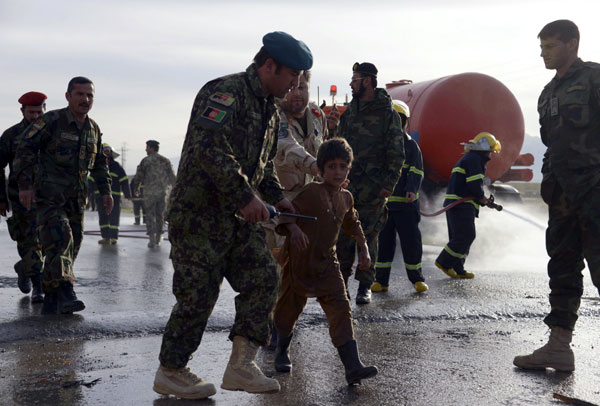Civilian casualties in Afghanistan hit record high - UN
(Agencies) Updated: 2016-02-14 16:07
 |
|
An Afghan National Army officer escorts a slightly injured boy from the site of a suicide attack on the outskirts of Mazar-i-Sharif, Afghanistan February 8, 2016.[Photo/Agencies] |
KABUL - Civilian casualties of the war in Afghanistan rose to record levels for the seventh year in row in 2015, as violence spread across the country in the wake of the withdrawal of most international troops, the United Nations reported on Sunday.
At least 3,545 noncombatants died and another 7,457 were injured by fighting last year in a 4-percent increase over 2014, the international organization said in its annual report on civilian casualties.
"The harm done to civilians is totally unacceptable," Nicholas Haysom, the head of the U.N. Assistance Mission in Afghanistan, said in a statement.
Increasingly desperate fighting between Western-backed government forces and insurgent groups meant more noncombatants are being caught in the crossfire, investigators wrote.
Ground engagements were the leading cause of civilian casualties at 37 percent, followed by roadside bombs at 21 percent and suicide attacks at 17 percent.
Women and children were especially hard hit, as casualties among women spiked 37 percent while deaths and injuries increased 14 percent among children.
Casualties attributed to pro-government security forces jumped 28 percent compared to 2014, for 15 percent of the total.
A 9-percent rise in civilian casualties caused by international military forces was attributed largely to a US air strike in October on a Doctors Without Borders hospital that killed 42 staff, patients, family members and injured another 43.
Overall 103 civilians were killed and 67 wounded by foreign forces last year, the report found.
As in past years, insurgent groups like the Taliban were blamed for the majority of civilian deaths and injuries, at 62 percent. Investigators accused insurgents of increasingly using tactics that "deliberately or indiscriminately" caused harm to civilians.
Residents in the north and south were particularly hard hit as Afghan security forces struggled to hold off resurgent Taliban offensives in Kunduz and Helmand provinces, among other areas.
"The report references commitments made by all parties to the conflict to protect civilians, however, the figures documented in 2015 reflect a disconnect between commitments made and the harsh reality on the ground," said Danielle Bell, director of the UN human rights programme in Afghanistan.
"The expectation of continued fighting in the coming months combined with the current levels of civilian casualties, demonstrate the critical need for immediate steps to be taken by all parties to the conflict to prevent harm to civilians," she said.
Since the United Nations began systematically recording civilian casualties in Afghanistan in 2009, it has documented nearly 59,000 deaths and injuries.
- US airstrikes kill 46 militants, destroy IS radio in Afghanistan
- Afghanistan's FM upbeat over talks
- Afghanistan gets clearance to join WTO
- China's relief aid arrives in quake-hit Afghanistan
- China's vice president pledges support in Afghanistan visit
- China-aid relief materials to be airlifted to Afghanistan






